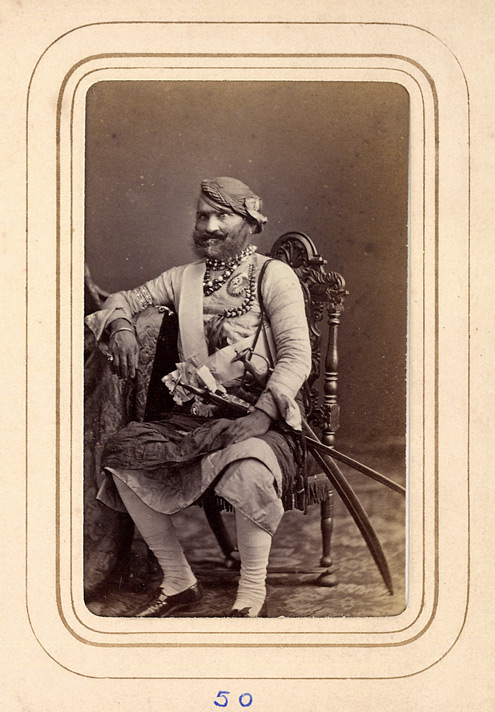|
Dholpur State
Dhaulpur State or Dholpur State, historically known as the Kingdom of Dholpur, was a kingdom of eastern Rajasthan, India, which was founded in Anno Domini, AD 1806 by a Jat ruler Rana (title), Rana Kirat Singh of Gohad State, Gohad. After 1818, the state was placed under the authority of British India's Rajputana Agency. The Ranas ruled the state until the independence of India in 1947, when the kingdom was merged with the India, Union of India. The princely state of Dholpur was located in the present-day state of Rajasthan. The state had an area of , and an estimated revenue of Rs.9,60,000. The former chief minister of Rajasthan, Vasundhara Raje, was a member of the erstwhile ruling family of Dholpur as she was married to Maharaja Hemant Singh before getting divorced. History Very little is known of the early history of the state. According to tradition a predecessor state was established as Dhavalapura. In 1505 neighboring Gohad State of Rana Jats was founded and between ... [...More Info...] [...Related Items...] OR: [Wikipedia] [Google] [Baidu] |
British India
The provinces of India, earlier presidencies of British India and still earlier, presidency towns, were the administrative divisions of British governance on the Indian subcontinent. Collectively, they have been called British India. In one form or another, they existed between 1612 and 1947, conventionally divided into three historical periods: *Between 1612 and 1757 the East India Company set up Factory (trading post), factories (trading posts) in several locations, mostly in coastal India, with the consent of the Mughal emperors, Maratha Empire or local rulers. Its rivals were the merchant trading companies of Portugal, Denmark, the Netherlands, and France. By the mid-18th century, three ''presidency towns'': Madras, Bombay and Calcutta, had grown in size. *During the period of Company rule in India (1757–1858), the company gradually acquired sovereignty over large parts of India, now called "presidencies". However, it also increasingly came under British government over ... [...More Info...] [...Related Items...] OR: [Wikipedia] [Google] [Baidu] |
Rajputana Agency
The Rajputana Agency was a political office of the British Indian Empire dealing with a collection of native states in Rajputana (now in Rajasthan, northwestern India), under the political charge of an Agent reporting directly to the Governor-General of India and residing at Mount Abu in the Aravalli Range. The total area of the states falling within the Rajputana Agency was , with eighteen states and two estates or chiefships. Subdivisions and (e)states * Mewar Residency, with headquarters at Udaipur, dealt with the state of Mewar (title Maharana of Udaipur), a salute state entitled to a hereditary gun salute of 19 guns (21 local). * Southern Rajputana States Agency, which was part of Mewar Residency until 1906, when it was separated, covered three salute states: ** Banswara, title Maharawal, hereditary 15 guns ** Dungarpur, title Maharawal, hereditary 15 guns ** Pratapgarh, title Maharawat, hereditary 15 guns * Jaipur Residency, with headquarters at Jaipur, dealt with ... [...More Info...] [...Related Items...] OR: [Wikipedia] [Google] [Baidu] |
Nihal Singh
Nihal Singh CB (4 May 1863 – 20 July 1901) was the Jat ruler of Dholpur state (1873–1901) in Rajasthan, India. Nihal Singh. Maharaj Rana of Dholpur. References *Dr. Ajay Kumar Agnihotri (1985) : "Gohad ke jaton ka Itihas" (Hindi) *Dr. Natthan Singh (2004) : "Jat Itihas" *Dr. Natthan Singh (2005): Sujas Prabandh (Gohad ke Shasakon ki Veer gatha – by Poet Nathan), Jat Veer Prakashan Gwalior 1863 births 1901 deaths Rulers of Dholpur state Companions of the Order of the Bath Recipients of the Kaisar-i-Hind Medal {{India-royal-stub ... [...More Info...] [...Related Items...] OR: [Wikipedia] [Google] [Baidu] |
Pohap Singh
Rana Pohap Singh was the Jat ruler of Dholpur state in (1836) in Rajasthan, India India, officially the Republic of India (Hindi: ), is a country in South Asia. It is the seventh-largest country by area, the second-most populous country, and the most populous democracy in the world. Bounded by the Indian Ocean on the so .... He was from Bamraulia gotra of Jats. He was elder son of Rana Kirat Singh and his successor. He ruled for nine months and died in 1836. After his death his younger brother Rana Bhagwant Singh ascended to the throne. References *Dr. Ajay Kumar Agnihotri (1985) : "Gohad ke jaton ka Itihas" (Hindi) *Dr. Natthan Singh (2004) : "Jat Itihas" *Jat Samaj, Agra: October–November 2004 *Dr. Natthan Singh (2005): Sujas Prabandh (Gohad ke Shasakon ki Veer gatha – by Poet Nathan), Jat Veer Prakashan Gwalior Rulers of Dholpur state 1836 deaths Year of birth unknown {{India-royal-stub ... [...More Info...] [...Related Items...] OR: [Wikipedia] [Google] [Baidu] |
Girdhar Pratap Singh
Girdhar Pratap Singh Rana was the ruler of Gohad Jat state in Madhya Pradesh Madhya Pradesh (, ; meaning 'central province') is a state in central India. Its capital is Bhopal, and the largest city is Indore, with Jabalpur, Ujjain, Gwalior, Sagar, and Rewa being the other major cities. Madhya Pradesh is the seco ..., India. He became the ruler of Gohad after the fall of Bhim Singh Rana. Rana Bhim Singh had no son. Girdhar Pratap Singh became his successor in 1755. Girdhar Pratap Singh was son of Samant Rao Balju, a family friend of Rana Bhim Singh. Girdhar Pratap Singh could not rule Gohad for long as he died in 1757. His successor was Rana Chhatar Singh (1757–1785). He was from Bamraulia gotra of Jats. He ruled Gohad state until 1757. References *Dr. Ajay Kumar Agnihotri (1985) : Gohad ke jaton ka Itihas(Hindi), Nav sahitya Bhawan, New Delhi. *Dr. Natthan Singh (2004) : Jat-Itihas, Jat Samaj Kalyan Parishad, Gwalior. * Balwantrao Bhaiya Saheb Sindhia: History ... [...More Info...] [...Related Items...] OR: [Wikipedia] [Google] [Baidu] |
Bhim Singh Rana
BHIM (Bharat Interface for Money) is an Indian mobile payment app developed by the National Payments Corporation of India (NPCI), based on the Unified Payments Interface (UPI). Launched on 30 December 2016, it is intended to facilitate e-payments directly through banks and encourage cashless transactions. It was named after the dalit leader Dr Bhimrao Ambedkar. The application supports all Indian banks which use UPI, which is built over the Immediate Payment Service (IMPS) infrastructure and allows the user to instantly transfer money between 170 member banks of any two parties. It can be used on all mobile devices. Operation BHIM allows users to send or receive money to or from UPI payment addresses, or to non-UPI based accounts (by scanning a QR code with account number and IFS code or MMID code). Unlike mobile wallets (Paytm, MobiKwik, mPesa, Airtel Money, etc.) which hold money, the BHIM app is only a mechanism which transfers money between different bank accounts ... [...More Info...] [...Related Items...] OR: [Wikipedia] [Google] [Baidu] |
Jats
The Jat people ((), ()) are a traditionally agricultural community in Northern India and Pakistan. Originally pastoralists in the lower Indus river-valley of Sindh, Jats migrated north into the Punjab region in late medieval times, and subsequently into the Delhi Territory, northeastern Rajputana, and the western Gangetic Plain in the 17th and 18th centuries. Quote: "Hiuen Tsang gave the following account of a numerous pastoral-nomadic population in seventh-century Sin-ti (Sind): 'By the side of the river.. f Sind along the flat marshy lowlands for some thousand li, there are several hundreds of thousands very great manyfamilies ..hichgive themselves exclusively to tending cattle and from this derive their livelihood. They have no masters, and whether men or women, have neither rich nor poor.' While they were left unnamed by the Chinese pilgrim, these same people of lower Sind were called Jats' or 'Jats of the wastes' by the Arab geographers. The Jats, as 'dromedary men.' we ... [...More Info...] [...Related Items...] OR: [Wikipedia] [Google] [Baidu] |
Matsya Union
The United States of Matsya, also called Matsya Union or Matsya Sangh, was a State of India which was formed on 18 March 1948 by the merger of four erstwhile princely states, Alwar, Bharatpur, Dholpur, and Karauli after accession. Shobha Ram Kumawat of Indian National Congress was the first and last chief minister of the State from 18 March 1948 till 15 May 1949. Maharaja of Dholpur became its Rajpramukh. On 15 May 1949, the Matsya Union was merged with Greater Rajasthan, to form the United State of Rajasthan, which later became the state of Rajasthan Rajasthan (; lit. 'Land of Kings') is a state in northern India. It covers or 10.4 per cent of India's total geographical area. It is the largest Indian state by area and the seventh largest by population. It is on India's northwestern s ... on 26 January 1950. References History of Rajasthan (1947–present) 1948 establishments in India Political integration of India Historical Indian regions States and terr ... [...More Info...] [...Related Items...] OR: [Wikipedia] [Google] [Baidu] |
Bharatpur State
Bharatpur State, which is also known as the Jat State of Bharatpur historically known as the Kingdom of Bharatpur, was a Hindu Kingdom in the northern part of the Indian subcontinent. It was ruled by the Sinsinwar clan of the Hindu Jats. At the time of reign of king Suraj Mal (1755–1763) revenue of the state was 17,500,000 rupees per annual. History The formation of the state of Bharatpur was a result of revolts by the Jats living in the region around Delhi, Agra, and Mathura against the imperial Mughals. Gokula, a local Jat zamindar of Tilpat, led the first of such revolts in 1669. Even though the Jats were defeated and Gokula was executed, the movement was not completely crushed and discontent continued to simmer. In 1685, there was a second uprising of the Jats under RajaRam of Sinsini, that was better organized this time and used guerrilla warfare, combining it with loot and plunder. Now Aurangzeb approached the Kachhwaha ruler Bishan Singh to crush the uprisin ... [...More Info...] [...Related Items...] OR: [Wikipedia] [Google] [Baidu] |
Gwalior Fort
The Gwalior Fort commonly known as the ''Gwāliiyar Qila'', is a hill fort near Gwalior, Madhya Pradesh, India. The fort has existed at least since the 10th century, and the inscriptions and monuments found within what is now the fort campus indicate that it may have existed as early as the beginning of the 6th century. The modern-day fort, embodying a defensive structure and two palaces was built by the Tomar Rajput ruler Man Singh Tomar. The fort has been administered by a number of different rulers in its history. The present-day fort consists of a defensive structure and two main palaces, "Man Mandir" and Gujari Mahal, built by Tomar Rajput ruler Man Singh Tomar (reigned 1486–1516 CE), the latter one for his wife, Queen Mrignayani. The second oldest record of ''"zero"'' in the world was found in a small temple (the stone inscription has the second oldest record of the numeric zero symbol having a place value as in the modern decimal notation), which is located on the w ... [...More Info...] [...Related Items...] OR: [Wikipedia] [Google] [Baidu] |





.jpg)

